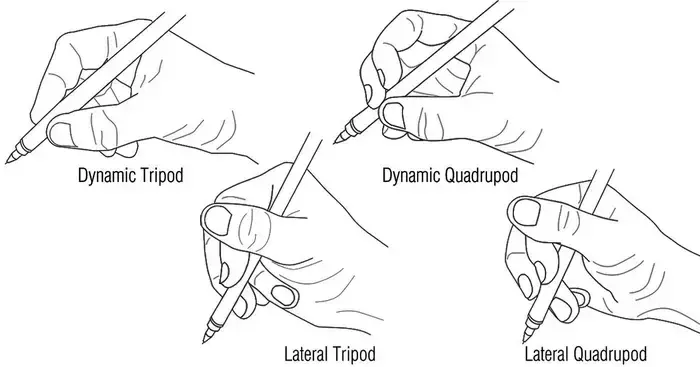Improving Pencil Grip for Young Children (Ages 3-5)
- ieaphonicsmath
- Oct 25, 2023
- 2 min read
𝗜𝗻𝘁𝗿𝗼𝗱𝘂𝗰𝘁𝗶𝗼𝗻: As children between the ages of 3 and 5 begin to explore the world of drawing and writing, it's imperative to ensure they develop a proper pencil grip. A correct grip not only enhances their fine motor skills but also will set the stage for effective communication through writing. This post will provide you with some tips on how to help your young child fix and improve their pencil grip.
𝗧𝗶𝗽𝘀 𝘁𝗼 𝗜𝗺𝗽𝗿𝗼𝘃𝗲 𝗣𝗲𝗻𝗰𝗶𝗹 𝗚𝗿𝗶𝗽 * 𝘾𝙝𝙤𝙤𝙨𝙚 𝙩𝙝𝙚 𝙍𝙞𝙜𝙝𝙩 𝙋𝙚𝙣𝙘𝙞𝙡𝙨: Start with pencils that are specifically designed for young children. These pencils are shorter and thicker, making them easier for small hands to hold.
* 𝘿𝙚𝙢𝙤𝙣𝙨𝙩𝙧𝙖𝙩𝙚 𝙩𝙝𝙚 𝘾𝙤𝙧𝙧𝙚𝙘𝙩 𝙂𝙧𝙞𝙥: Show your child how to hold a pencil correctly. The ideal grip involves holding the pencil between the thumb and the index finger, with the middle finger supporting from underneath.
* 𝙐𝙨𝙚 𝘿𝙧𝙖𝙬𝙞𝙣𝙜 𝙀𝙭𝙚𝙧𝙘𝙞𝙨𝙚𝙨: Encourage your child to engage in fun drawing activities. Most youngsters will start by drawing lines, vertical and horizontal. You can then encourage them to draw circles. Drawing helps build the necessary fine motor skills and encourages a natural grip.
* 𝙋𝙧𝙤𝙫𝙞𝙙𝙚 𝙏𝙤𝙤𝙡𝙨: If your child struggles with the grip, consider using tools like triangular or ergonomic grips that are designed to facilitate a proper pencil grip. These can be used as a transition to a standard pencil grip. But make sure they do not rely solely on these grips.
* 𝙁𝙧𝙚𝙦𝙪𝙚𝙣𝙩 𝙋𝙧𝙖𝙘𝙩𝙞𝙘𝙚: Offer plenty of opportunities for your child to practice drawing and writing. The more they practice, the better their grip will become over time.
* 𝙈𝙤𝙣𝙞𝙩𝙤𝙧 𝙋𝙧𝙤𝙜𝙧𝙚𝙨𝙨: Pay attention to your child's grip as they draw or write. Gently correct them if you notice their grip slipping back into an improper position. It might seem tedious but consistently correcting their grip each time will eventually pay off.
* 𝘽𝙚 𝙋𝙖𝙩𝙞𝙚𝙣𝙩: Understand that it may take time for your child to develop the perfect grip. Avoid putting too much pressure on them and encourage a relaxed approach to learning.
𝗖𝗼𝗺𝗺𝗼𝗻 𝗠𝗶𝘀𝘁𝗮𝗸𝗲𝘀 𝘁𝗼 𝗔𝘃𝗼𝗶𝗱 Here are some common mistakes to watch out for and avoid:
* 𝘿𝙚𝙖𝙩𝙝 𝙂𝙧𝙞𝙥: A grip that's too tight can lead to hand fatigue and discomfort.
* 𝙐𝙨𝙞𝙣𝙜 𝙩𝙝𝙚 𝙋𝙞𝙣𝙠𝙮: The pinky finger should not be under the pencil; it should be relaxed and not in use during writing or drawing.
* 𝙏𝙝𝙪𝙢𝙗 𝙒𝙧𝙖𝙥𝙥𝙞𝙣𝙜: Ensure the thumb doesn't wrap over the index finger; instead, it should be positioned opposite the index finger.
𝗖𝗼𝗻𝗰𝗹𝘂𝘀𝗶𝗼𝗻: Teaching your young child the proper pencil grip is an important step in their development. By following these tips and strategies, you can help them build the fine motor skills and habits necessary for successful writing and drawing. Remember to be patient, encouraging, and, most importantly, make the learning process enjoyable for your child.




Comments